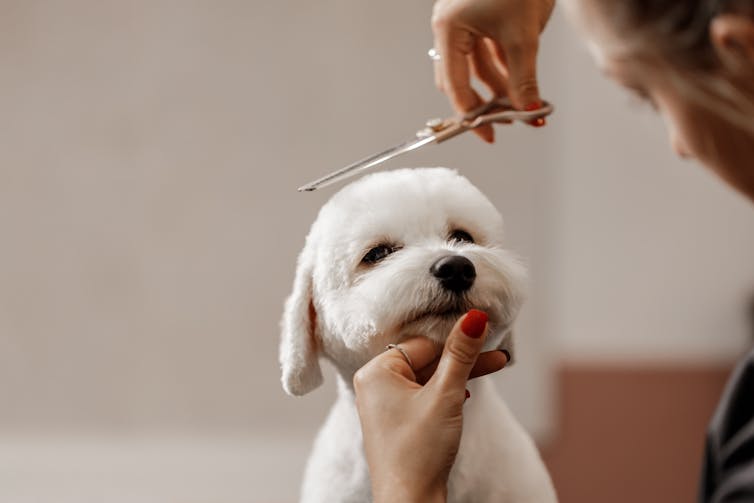Labradoodles, Puggles, Dorgis, Cavoodles, Cavapoos: whatever you call them, you can’t escape the explosion of designer mixes parading our streets and dog parks these days.
People have chosen these hybrid dogs as the health problems associated with purebred breeds have become more widely known. The theory is that designer dogs from crossbreeds are more genetically diverse and therefore suffer less from the health problems of purebred dogs.
But are these designer hybrids actually healthier than their purebred counterparts? Researchers at the Royal Veterinary College in the UK set out to answer this question in a new article published overnight.
The study focused on three common poodle crossbreeds: Cockapoos, Labradoodles and Cavapoos. It found that they were no healthier or less healthy than their purebred counterparts. Researchers hope the results will help dog owners make more informed, evidence-based decisions when choosing their next furry friend.

Shutterstock
Designer hybrids
Most dogs alive today were not bred under human control. Nevertheless, in about 200 years, humans have created more than 400 modern dog breeds, each with its own unique appearance and temperament.
Some popular dog breeds, such as the Golden Retriever, have a mixed-breed origin story. However, many are “pedigree dogs” bred from a limited gene pool.
Proponents of purebred dogs say their health, behavior and appearance are more predictable. And many stud books no longer allow the inclusion of mixed-breed dogs.
Over time, however, this lack of genetic diversity among purebred dogs has led to extreme body types and serious welfare problems for many dogs.
To solve these problems, some breeders resort to “outcrossing”: the deliberate mating of two dogs of different breeds. The aim is to mitigate inherited physical or behavioral problems and to produce healthier puppies. The goal is for the offspring to prove more robust than their parents, which is also known as “hybrid vigor.”
This has led to an increase in “designer crossbreeding”. In particular, Poodles have been crossed with other breeds such as:
-
the cross between Cavalier King Charles Spaniel, known in Australia as Cavoodle and in the United Kingdom as Cavapoo
-
the cross between a Cocker Spaniel, known in Australia as a “Spoodle” and in Great Britain as a “Cockapoo”
-
The Labrador Retriever mix, known as the Labradoodle. This mix was originally bred by an Australian to create a non-allergenic guide dog.

Shutterstock
Lots of health problems?
The Royal Veterinary College study included a survey of around 9,400 people.
Some owned a mixed breed dog – either a Cockapoo (Spoodle), Cavapoo (Cavoodle) or Labradoodle. Others owned one of their purebred “ancestors” or founder dogs – either a Cavalier King Charles Spaniel, Cocker Spaniel, Labrador Retriever or Poodle. All dogs were under five years old.
The authors tested the assumption that designer crosses are less likely to suffer from common diseases compared to their founder breeds.
They compared the probability of the 57 most common health disorders in the three designer crosses with each of their founder breeds (ancestors). A total of 342 comparisons were made.
The most common health problems included eye and ear infections, diarrhea and cruciate ligament tears.
And the results? The poodle mixes and comparable dogs of the same breed had the same health results in 87% of cases.
Mixed race individuals were more likely to experience a small number of disorders (7%), but less likely to experience other disorders (6%).
Overall, there was no convincing evidence of “hybrid livestock strength” in these poodle crosses. Nor was there any evidence that the purebred dogs were significantly healthier than the designer crossbred dogs.

Shutterstock
What does all this mean?
In view of their results, the authors concluded that future dog owners should also consider other factors when purchasing a dog, such as the breeding conditions, temperament and health of the puppy’s parents.
The study focused only on young adult dogs. Crossbreeding can provide health benefits that aren’t apparent until later in life, so a study replicating these questions in older dogs would help us understand how designer crossbreeds age and identify risk factors so we can help them age well.
Importantly, the study only examined three types of crossbreeds, all of which were poodles. Other designer crossbreeds may be healthier than their purebred counterparts.
For example, dogs with flat muzzles such as pugs and French bulldogs often suffer from breathing difficulties and skin and eye problems. By crossing these breeds with other dogs, their faces could be given a proper muzzle, which would have a positive effect on their health and well-being.

Shutterstock
Who could dogs be?
All this raises important questions. Where Do the animals in our lives come from? How are they bred and is this information transparent? Are we happy with current breeding practices? And if not, what needs to change?
It goes without saying that when we look for the perfect canine companion, we want a dog that is healthy, long-lived and happy to live with us.
These qualities are good for the dog. And for their owners too. A healthy dog means fewer vet bills. A longer life means more time spent together, and a happy life with us means less stress and a better quality of life for everyone in the house.
So how do we find this dog?
In some European countries, dogs must meet strict physical, genetic and behavioural requirements before they can be registered and used for breeding. This requires a nationally consistent licensing system and well-resourced enforcement – both of which are lacking in Australia.
Whether dogs are healthy, long-lived and happy is ultimately up to us. Breeders decide which dogs are bred. Dog lovers decide which puppies to buy. And when we vote, we help decide how governments regulate the breeding industry.
In the interest of our canine friends, I hope we make the right choice.

